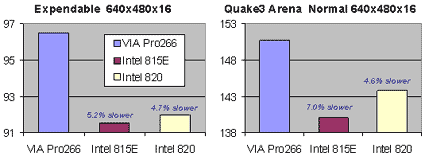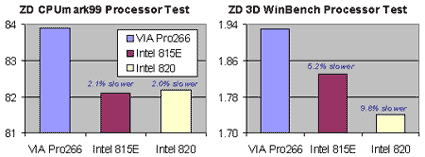Bert McComas van InQuest Market Research heeft een artikel geschreven waarin wordt gekeken naar de snelheidsverbetering die DDR geheugen geeft in combinatie met de Pentium III en VIA Apollo Pro266 chipset. Het blijkt dat de snelheid niet drastisch omhoog gaat als er DDR geheugen wordt gebruikt in plaats van SDR of Rambus geheugen, afhankelijk van de benchmarks is er in de meeste gevallen een snelheidswinst van 2% tot 10% te zien. Deze resultaten mogen misschien niet al te schokkend zijn, maar als je meerekent dat DDR geheugen op den duur even goedkoop zal worden als SDR geheugen is deze verbetering in performance niet slecht. Verder zijn deze resultaten ook niet heel erg slecht als je bedenkt dat de Pentium III slechts een FSB heeft van 100MHz of 133MHz en dus nauwelijks kan profiteren van DDR geheugen. Voor echte interessante resultaten met DDR geheugen zal je dus niet bij de Pentium 3 moeten zijn, maar bij de Duron of Athlon en misschien in de toekomst bij de Pentium 4:
Game performance is a factor that is closely scrutinized in the market today. Two of the more commonly benchmarked games are Quake3 and Expendable. Default resolution modes were used in both cases in order to remove the question of possible accelerator bottlenecks. The Apollo Pro266 performance advantage is a healthy 4-7% as seen in the charts below. These benchmarks stress the processor’s floating-point unit, DRAM performance and CPU to AGP command traffic for the accelerator. DDR’s high bandwidth and low latency benefit all of these functions, delivering a performance advantage that is nearly equivalent to one CPU speed grade. This is an attractive advantage for P3 game enthusiasts.
CPUmark99 and the 3D WinBench Processor Test from Ziff Davis shown in the chart below also indicate a consistent advantage for DDR. CPUmark99 is a very processor centric benchmark. Though it does produce some DRAM activity, its results are muted slightly compared to many of the other benchmarks. On the other hand, 3D WinBench produces results that are consistent, or even magnify the observations from the 3D game benchmarks.
[...] Overall, these benchmarks seem to indicate an attractive performance advantage for DDR and VIAs’ Apollo Pro266 chip set. This performance advantage cannot be attributed to latency differences alone, since both SDRAM systems were configured to the slowest CL3 timings. In fact, there is still plenty of room for further DDR performance optimization, as CL2.5 and CL2.0 become the dominant speed grades.


